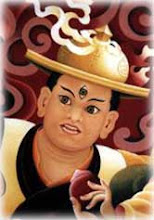In the commentary Heart Jewel, Geshe Kelsang explains the spiritual history of the Dharma Protector Dorje Shugden -- a short account that is deeply inspiring to practitioners and that evokes great faith. It is enough history for many who have faith in their spiritual teachers, lineage and Protector.
Now a new website has been completed, which gives more detail and historical context through which everyone, even the most skeptical, can hopefully start to see that Dorje Shugden has always been relied upon as a Buddha.
This website uncovers the texts, rituals, historical works and art dedicated to the practice of the Wisdom Buddha Dorje Shugden. As the author, Trinley Kalsang, explains:
"Although there are many texts that reveal the gradual development of the system of ritual for this deity, much of this has not been brought out in the open for examination."
Much of this material in fact has been deliberately suppressed because it proves that Dorje Shugden has been considered an enlightened being and the Protector of the Gelug lineage for several hundred years, since he first arose in this form; and this quite obviously undermines the 14th Dalai Lama's pronouncements of Dorje Shugden being a spirit of the dark forces, a Chinese demon, and so on.
Trinley Kalsang, a scholar of Tibetan, focuses on works from the time period before the 20th century. He leaves aside the works of Pabongkha Rinpoche and Trijang Rinpoche with the exception of various references to how these have drawn upon these earlier works. In particular, it can now be seen how the basic components of the practice were originally developed within the Sakya tradition and then incorporated into the Gelug tradition.
In particular, these translations and essays naturally disprove many of the fallacious ideas written in The Shuk-den Affair by Georges Dreyfus, who put the onus of the development and spread of Dorje Shugden on the individual figure of Pabongkha Rinpoche in the 20th century. He was not the first to do so, but he lent the Dalai Lama's claim Western academic credibility and enabled copy cat commentators, altogether doing a great deal of damage to the reputation of Dorje Shugden and his followers.
As Trinley Kalsang explains, the presentation of The Shuk-den Affair follows the same approach as that found in polemical Tibetan works, including the Brief History of Opposition to Shugden by the Tibetan Government in Exile's “Dolgyal Research Committee", the main thrust of which is to discredit the Dorje Shugden practice by discrediting Pabongkha Rinpoche. With this approach, the existing practice is presented as a whimsical device of one person rather than as a true spiritual practice with precedence. With The Shuk-den Affair, Dreyfus took this same pre-existing presentation and wrapped it in a seemingly scholarly package.
Dreyfus therefore got behind the Dalai Lama and his Government in Exile in discrediting the practice of Dorje Shugden and falsely accusing the highly revered Gelugpa Lama Je Phabongkhapa of possessing a sectarian agenda. Regrettably, some later Western commentators such as David Kay relied upon Dreyfus's work as the basis for their own inaccurate and defamatory accounts of the Wisdom Buddha without doing the original research that would have shown them that Dreyfus's work was full of problems and political bias to begin with. Consciously or not, these commentators' omission in doing decent research, relying so heavily on accounts by the Dalai Lama, TGIE and Dreyfus, seems to have arisen from trying to stay on the right side of the Tibetan power structure. It appears that they took as their starting point the assumption that the Dalai Lama must be right and skewed the history to fit with this. Had they found these collected works, and used them, they might have been able to tell a more accurate story.
The main sources for this website were originally collected by the Mongolian scholar and master Lobsang Tamdin (1867-1937), who gathered a number of earlier texts written by Mongolian and Tibetan masters. Regardless of where individuals stand on whether or not people should be allowed to continue their practice of Dorje Shugden, the translations on this website prove that Pabongkha Rinpoche did not invent any aspect of this practice, but merely absorbed and propagated it.The translations speak for themselves -- not a lot of added interpretation or polemics are required to challenge the views of the Dalai Lama, the TGIE, Dreyfus, and other detractors.
As the author says:
"In short, it has been revealed from historical sources that Dorje Shugden is the Three Bodhisattvas: Avalokiteshvara, Vajrapani and Manjushri. He is the sole protector ever to bear the title Protector of the Conqueror Manjunatha, having the responsibility to protect and promote the doctrine of the Second Buddha Jamgon Lama Tsongkhapa. "




